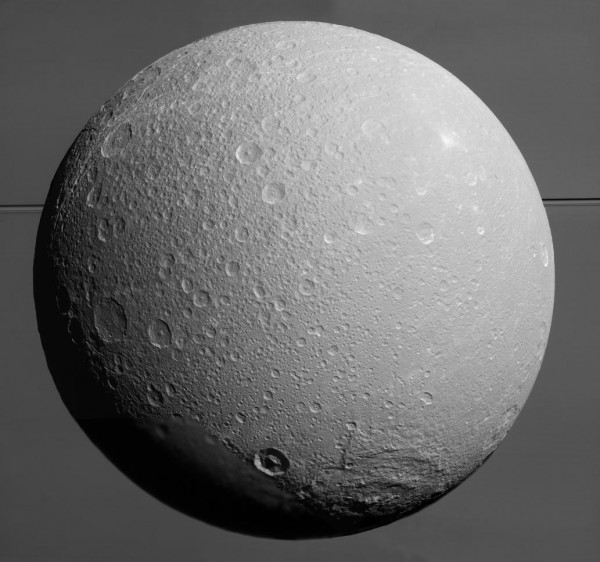By Ana Verayo, | October 04, 2016

This view from NASA's Cassini spacecraft looks toward Saturn's icy moon Dione, with giant Saturn and its rings in the background.
Scientists have revealed in a new study that Saturn's moon Dione is also host to a hidden ocean under its crust, confirming past evidence.
In a 2013 study, NASA's Cassini spacecraft collected data on Saturn's moon, suggesting that the moon's topography indicates that it might hold a global ocean underneath its surface. This hidden ocean has apparently caused the moon's crust to crack and suffer from internal stresses.
Like Us on Facebook
In this new study, a team from the Royal Observatory of Belgium created a new computer model to demonstrate the gravitational forces of Dione that was observed during Cassini's flybys. The data revealed that the moon's crust is covering this ocean, which is 62 miles deep.
When this global ocean under its crust is confirmed, Dione will become Saturn's third moon to possess an ocean under its surface, along with Titan and Enceladus. More importantly, the presence of these oceans hints at possible microbial life.
Researchers believe that this newly discovered ocean can reach tens of kilometers deep below its crust, which surrounds Dione's large rocky core within its interior. Dione's appearance and composition are also similar to Enceladus. However, the moon is smaller. This suggests that both moons are covered in icy shells.
According to the lead author of the study, Mikael Beuthe of the Observatoire Royal de Belgique, this new model indicates that the ocean in Enceladus is closer to the surface, near the southern polar region, as opposed to Dione. Geysers have been also observed erupting through this thin crust. This new study has also confirmed data from Cassini that supports the theory that Enceladus is experiencing some orbital oscillations.
On the contrary, Dione possesses a deeper global ocean underneath its crust near its core. The researchers confirmed that Dione is also affected by orbital oscillations. However, Cassini was unable to detect them.
This new study has been published in the journal, Geophysical Research Letters.
-
Use of Coronavirus Pandemic Drones Raises Privacy Concerns: Drones Spread Fear, Local Officials Say

-
Coronavirus Hampers The Delivery Of Lockheed Martin F-35 Stealth Fighters For 2020

-
Instagram Speeds Up Plans to Add Account Memorialization Feature Due to COVID-19 Deaths

-
NASA: Perseverance Plans to Bring 'Mars Rock' to Earth in 2031

-
600 Dead And 3,000 In The Hospital as Iranians Believed Drinking High-Concentrations of Alcohol Can Cure The Coronavirus

-
600 Dead And 3,000 In The Hospital as Iranians Believed Drinking High-Concentrations of Alcohol Can Cure The Coronavirus

-
COVID-19: Doctors, Nurses Use Virtual Reality to Learn New Skills in Treating Coronavirus Patients







